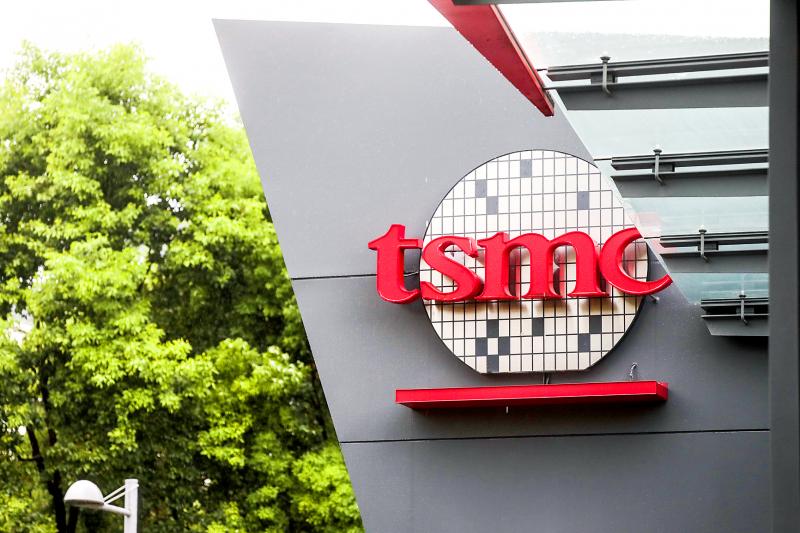Taiwan Semiconductor Manufacturing Co (TSMC, 台積電), the sole chip supplier for Apple Inc’s iPhone series, yesterday raised its revenue forecast again, saying that robust demand for 5G smartphones and high-performance-computing (HPC) would help boost revenue this year by 30 percent in US dollar terms.
Three months ago, the chipmaker estimated that revenue would grow 20 percent this year from last year, reaching its long-term growth target of 15 to 20 percent annually.
“Moving into the fourth quarter, we expect our growth in revenue to be supported by strong demand for our industry-leading 5-nanometer technology driven by 5G smartphone launches and HPC-related applications,” TSMC chief executive officer C.C. Wei (魏哲家) told investors in a telephone conference.

Photo: Chen I-hwa, Bloomberg
TSMC’s net profit climbed 13.6 percent to a new record high of NT$137.31 billion (US$4.74 billion) last quarter, from NT$120.82 billion in the second quarter, and grew 35.9 percent from NT$101.07 billion a year earlier.
Earnings per share rose to NT$5.3 last quarter from NT$4.66 a quarter earlier and NT$3.9 a year earlier.
The chipmaker expects the penetration rate of 5G smartphones to reach 17 or 18 percent this year, with each 5G phone featuring 30 to 40 percent more semiconductors than 4G models.
Given the growth momentum of 5G and HPC-related applications, TSMC said it is confident that 5-nanometer technology — the most advanced technology available — would make up 8 percent of the company’s total wafer revenue this year, Wei said, adding that this figure might increase to 20 percent next year.
This quarter, revenue would grow mildly to between US$12.4 billion and US$12.7 billion, representing growth of between 2.14 and 4.61 percent from US$12.14 billion last quarter, TSMC said.
Gross margin is to reach between 51.5 and 53.5 percent, compared with 53.4 percent last quarter, due to unfavorable foreign-exchange rates and margin dilution from its 5-nanometer technology, it added.
TSMC said that Huawei Technologies Co (華為) would not contribute to its revenue this quarter, as it stopped shipping chips to the Chinese company on Sept. 15.
The chipmaker dismissed recent media speculations that it has obtained approval from the US government to resume the supply of certain chips to Huawei.
This was “unfounded,” Wei said.
Asked by an investor whether Washington’s export restrictions on Semiconductor Manufacturing International Co (中芯國際), China’s biggest foundry, would provide a boon for TSMC, Wei said the company is evaluating the impact.
Due to the COVID-19 pandemic, heightened US-China trade and other geopolitical tensions, customers tended to increase their inventory, Wei said, adding that customers are concerned about potential long-lasting supply disruptions.
Asked if TSMC has plans to build factories outside Taiwan to minimize operational risks amid heightened tension across the Taiwan Strait, Wei said that it would keep its investment focus on Taiwan, as it remains the center of its research, development and manufacturing.
The chipmaker also adjusted upward its worldwide revenue forecast for the semiconductor industry to a 5 percent annual growth, rather than a slight increase.
The foundry sector would grow about 20 percent year-on-year, faster than the previous estimate of between 15 and 17 percent, it said.
“Due to the pandemic, digital transformation has been accelerated,” Wei said.

TECH BOOST: New TSMC wafer fabs in Arizona are to dramatically improve US advanced chip production, a report by market research firm TrendForce said With Taiwan Semiconductor Manufacturing Co (TSMC, 台積電) pouring large funds into Arizona, the US is expected to see an improvement in its status to become the second-largest maker of advanced semiconductors in 2027, Taipei-based market researcher TrendForce Corp (集邦科技) said in a report last week. TrendForce estimates the US would account for a 21 percent share in the global advanced integrated circuit (IC) production market by 2027, sharply up from the current 9 percent, as TSMC is investing US$65 billion to build three wafer fabs in Arizona, the report said. TrendForce defined the advanced chipmaking processes as the 7-nanometer process or more

China’s Huawei Technologies Co (華為) plans to start mass-producing its most advanced artificial intelligence (AI) chip in the first quarter of next year, even as it struggles to make enough chips due to US restrictions, two people familiar with the matter said. The telecoms conglomerate has sent samples of the Ascend 910C — its newest chip, meant to rival those made by US chipmaker Nvidia Corp — to some technology firms and started taking orders, the sources told Reuters. The 910C is being made by top Chinese contract chipmaker Semiconductor Manufacturing International Corp (SMIC, 中芯) on its N+2 process, but a lack

Who would not want a social media audience that grows without new content? During the three years she paused production of her short do-it-yourself (DIY) farmer’s lifestyle videos, Chinese vlogger Li Ziqi (李子柒), 34, has seen her YouTube subscribers increase to 20.2 million from about 14 million. While YouTube is banned in China, her fan base there — although not the size of YouTube’s MrBeast, who has 330 million subscribers — is close to 100 million across the country’s social media platforms Douyin (抖音), Sina Weibo (新浪微博) and Xiaohongshu (小紅書). When Li finally released new videos last week — ending what has

NVIDIA PLATFORM: Hon Hai’s Mexican facility is to begin production early next year and a Taiwan site is to enter production next month, Nvidia wrote on its blog Hon Hai Precision Industry Co (鴻海精密), the world’s biggest electronics manufacturer, yesterday said it is expanding production capacity of artificial intelligence (AI) servers based on Nvidia Corp’s Blackwell chips in Taiwan, the US and Mexico to cope with rising demand. Hon Hai’s new AI-enabled factories are to use Nvidia’s Omnivores platform to create 3D digital twins to plan and simulate automated production lines at a factory in Hsinchu, the company said in a statement. Nvidia’s Omnivores platform is for developing industrial AI simulation applications and helps bring facilities online faster. Hon Hai’s Mexican facility is to begin production early next year and the